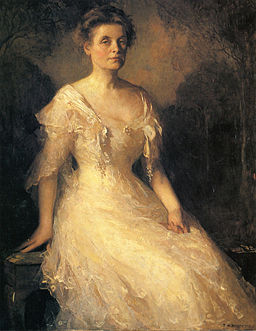I follow the light, where it comes from, where it goes
Frank Weston Benson

Lily Pond,1923
Born on March 24, 1862 Frank Weston Benson was an American Impressionist painter from Salem, Massachusetts and a founding member of the Ten American Painters which included Childe Hassam and Joseph DeCamp. Of the three, Benson is the most impressionist, with thick dry brushstrokes and a more vibrant use of color both in his highlights and shadows. Benson is known also for his variety of subject matter and use of various media in which he used everything from wet and dry media to lithography and etching to capture not only landscapes and figures but wildlife, especially birds and fowl. His career was filled with numerous accolades and memberships, his exhibitions very successful, and today his work can be found in many museums across the United States. Read more about his life here.
Just looking at Lily Pond above, we see a sensitive eye with a deep respect for light and color. Although the composition seems to derive from a photograph, its low-perspective is intriguing and beautiful. His brushwork is so dry that this could be easily mistaken for pastel. Benson's use of color is utterly hypnotic yet natural as he leads our eye around the painting effortlessly in a shimmer of warm-cools and cool-warms in those reflections. The foreground bares the tall trees pointing downward toward us with a lazy blue afternoon sky behind them, and yet those floating lilies appear so palpable and real. Benson defies the simplistic notion of the "focal point" and instead by concentrating on the moment, the feel of the environment and the quiet mood, he presents a philosophical view of nature's mysterious and profound beauty for us to contemplate. And relish.

Eleanor, 1907
A gorgeous portrait, this is one painting that would be a treat to see in person. Rather matter-of-fact in representation, Benson instead infuses color and light here to contrast her warm pink dress against a background of lush yellow-greens and blues. The inclusion of the fence adds character and earthiness to this bright sunny afternoon, and her gentle glowing dress with both blues and pinks with greys adds dimension to what would otherwise be a banal portrait. I like the rim-light of the sun on her reddish-brown hair. Monet would have heartily approved of this portrait.

Girls in the Garden, c. 1906
A portrait of his family under the late afternoon sun, Benson is all about color here. Those yellow-green grass brushstrokes in the foreground are pure fun. Notice how he pays little attention to the faces and focuses more on the beauty they are enveloped in. An interesting composition here, Benson uses the triangle to establish age and family rank order, which is an intelligent device. No more explanation is required. Beauty, pure and simple.

The Landing, 1904
Stunning brushwork in this painting. Again, the painting itself is the focal point, the rich sumptuous blues and the feel of being outdoors on this windy afternoon. Note the range of values in the blue of the water. And the variety of colors. A beautiful painting.

Elizabeth Perley Kinnicutt, 1909
An example of Benson's formal portraiture. Here he shows he can hold his own against the likes of contemporaries such as Sargent and Chase with ease. Elegant, dramatic, glowing warm brushstrokes in the dress against a rusty background and a sincere facial expression. Benson can do it all.

Mount Monadnock, c. 1890
An outdoor splendour that takes us into the fresh air. The use of various greens here against the atmospheric perspective of the distant mountains and sky is breathtaking, trite as it may seem to say it. His values are spot on.

The Grey Room, 1913
A great modern chiaroscuro study that regrettably I was unable to find in a larger image for us to view. The influence of Dutch Old Masters such as Rembrandt is clear. Note the subtle colors in the shadows of her dress. This is one of his very best.

Fire on the Beach, 1925
A subject that rarely gets enough attention but here is as natural and familiar as ever. This is pure atmosphere and it works. Anyone wondering why artists need to learn so much about greys need no longer ask...this painting is evidence alone. The contrast of water, smoke, earth and sky is utter poetry.

A seascape with the fury of a Turner but tighter, Benson captures a riveting sunset against the crashing waves of the ocean and invites us to experience it. Look at the muted greens in the water. All art is an invitation to experience how beautiful and mysterious life is. Benson knew this, and we are enriched from his attentive eye. He was one of the last great Impressionists, and the evidence is all here.
Comments
Post a Comment